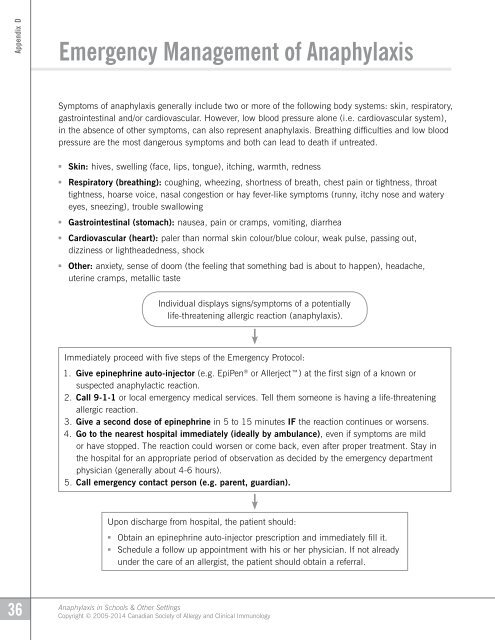Anaphylaxis in Schools 3rd Edition
Anaphylaxis in Schools 3rd Edition
Anaphylaxis in Schools 3rd Edition
Create successful ePaper yourself
Turn your PDF publications into a flip-book with our unique Google optimized e-Paper software.
Appendix D<br />
Emergency Management of <strong>Anaphylaxis</strong><br />
Symptoms of anaphylaxis generally <strong>in</strong>clude two or more of the follow<strong>in</strong>g body systems: sk<strong>in</strong>, respiratory,<br />
gastro<strong>in</strong>test<strong>in</strong>al and/or cardiovascular. However, low blood pressure alone (i.e. cardiovascular system),<br />
<strong>in</strong> the absence of other symptoms, can also represent anaphylaxis. Breath<strong>in</strong>g difficulties and low blood<br />
pressure are the most dangerous symptoms and both can lead to death if untreated.<br />
• Sk<strong>in</strong>: hives, swell<strong>in</strong>g (face, lips, tongue), itch<strong>in</strong>g, warmth, redness<br />
• Respiratory (breath<strong>in</strong>g): cough<strong>in</strong>g, wheez<strong>in</strong>g, shortness of breath, chest pa<strong>in</strong> or tightness, throat<br />
tightness, hoarse voice, nasal congestion or hay fever-like symptoms (runny, itchy nose and watery<br />
eyes, sneez<strong>in</strong>g), trouble swallow<strong>in</strong>g<br />
• Gastro<strong>in</strong>test<strong>in</strong>al (stomach): nausea, pa<strong>in</strong> or cramps, vomit<strong>in</strong>g, diarrhea<br />
• Cardiovascular (heart): paler than normal sk<strong>in</strong> colour/blue colour, weak pulse, pass<strong>in</strong>g out,<br />
dizz<strong>in</strong>ess or lightheadedness, shock<br />
• Other: anxiety, sense of doom (the feel<strong>in</strong>g that someth<strong>in</strong>g bad is about to happen), headache,<br />
uter<strong>in</strong>e cramps, metallic taste<br />
Individual displays signs/symptoms of a potentially<br />
life-threaten<strong>in</strong>g allergic reaction (anaphylaxis).<br />
Immediately proceed with five steps of the Emergency Protocol:<br />
1. Give ep<strong>in</strong>ephr<strong>in</strong>e auto-<strong>in</strong>jector (e.g. EpiPen ® or Allerject) at the first sign of a known or<br />
suspected anaphylactic reaction.<br />
2. Call 9-1-1 or local emergency medical services. Tell them someone is hav<strong>in</strong>g a life-threaten<strong>in</strong>g<br />
allergic reaction.<br />
3. Give a second dose of ep<strong>in</strong>ephr<strong>in</strong>e <strong>in</strong> 5 to 15 m<strong>in</strong>utes IF the reaction cont<strong>in</strong>ues or worsens.<br />
4. Go to the nearest hospital immediately (ideally by ambulance), even if symptoms are mild<br />
or have stopped. The reaction could worsen or come back, even after proper treatment. Stay <strong>in</strong><br />
the hospital for an appropriate period of observation as decided by the emergency department<br />
physician (generally about 4-6 hours).<br />
5. Call emergency contact person (e.g. parent, guardian).<br />
Upon discharge from hospital, the patient should:<br />
• Obta<strong>in</strong> an ep<strong>in</strong>ephr<strong>in</strong>e auto-<strong>in</strong>jector prescription and immediately fill it.<br />
• Schedule a follow up appo<strong>in</strong>tment with his or her physician. If not already<br />
under the care of an allergist, the patient should obta<strong>in</strong> a referral.<br />
36<br />
<strong>Anaphylaxis</strong> <strong>in</strong> <strong>Schools</strong> & Other Sett<strong>in</strong>gs<br />
Copyright © 2005-2014 Canadian Society of Allergy and Cl<strong>in</strong>ical Immunology


